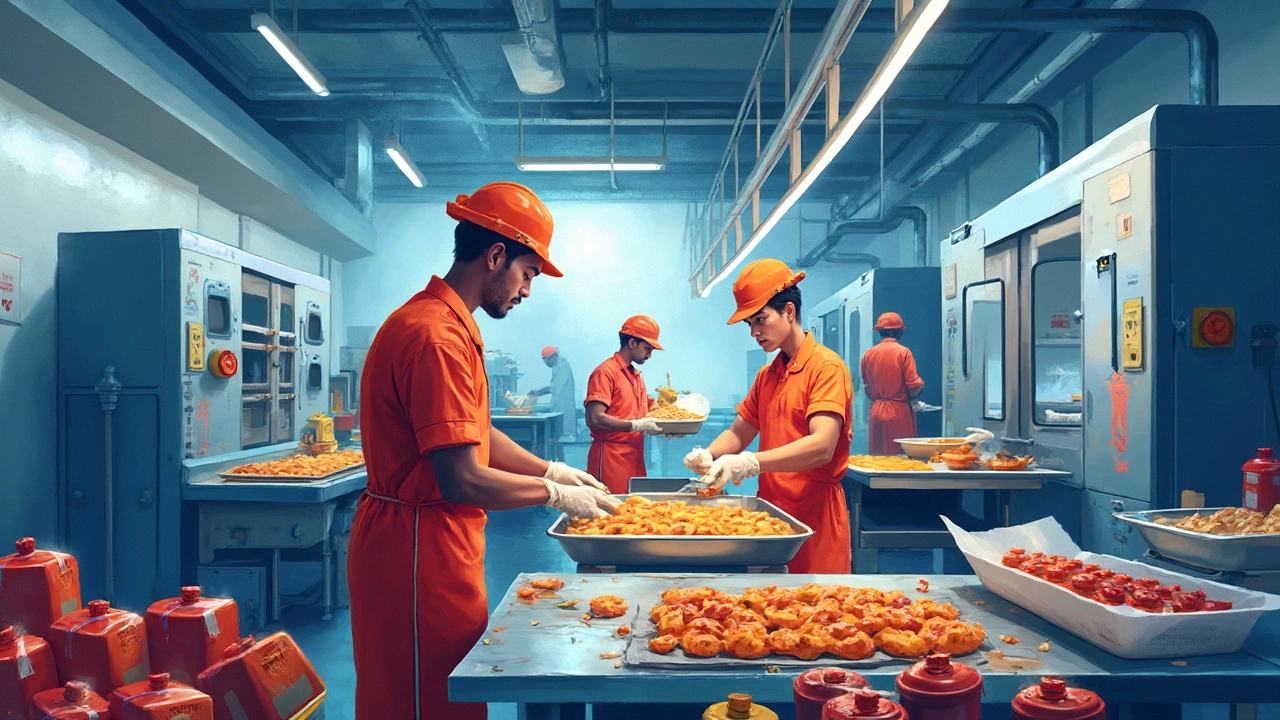What Food Item Rakes in the Most Profit?

If you've ever wondered which food items bring home the bacon, you're not alone. The answer might surprise you. It's not always the gourmet meals or high-end desserts making the big bucks. Often, simple, everyday snacks like potato chips are the top earners in food processing units. Chips have the perfect mix of low production cost and high consumer demand, making them one of the most profitable items.
Beverages also play a massive role in the profit game. Coffee drinks and energy beverages are more than just morning staples—they're cash cows in disguise. The markup on a cup of coffee is astronomical when you think about it, and that's what makes it a top money-maker.
- The King of Snacks
- Beverages that Take the Lead
- Ready-to-Eat Meals on the Rise
- The Influence of Global Trends
- Balancing Quality with Profit
The King of Snacks
When it comes to making money in food processing, snack foods reign supreme. Potato chips, for example, are not just a comfort food staple; they've become a cash machine for processors all over the globe. This is because of their incredibly low cost of production, combined with high demand worldwide.
Why Potato Chips Hit the Jackpot
First off, let's talk about the ingredients. Potatoes are dirt cheap, especially when bought in bulk. Add a little oil and seasoning, and you've got a snack that's quick and easy to produce. They travel well and have a long shelf life, which makes them ideal for distribution far and wide.
According to a recent industry report, potato chips are up there as one of the most popular snacks with around 1.2 billion units sold annually in the U.S. alone!
Packaging and Marketing Magic
Another reason these snacks are rolling in profits is the packaging. Bright, attractive bags that don't break the bank add to the allure of the colorful snack aisles. Couple this with targeted marketing, celeb endorsements, or seasonal flavors, and you've got a recipe for skyrocketing sales.
Revenue also gets a boost from brand loyalty. Companies like Lays or Pringles have been household names for years, and this familiarity keeps consumers coming back for more.
Broad Appeal and Accessibility
Chips appeal to all age groups and are perfect for all sorts of occasions, from game nights to picnics. They are readily available in both high-end boutique stores and your local convenience shop. You won’t just find them at the grocery; think vending machines, gas stations, and even as side orders at cafes.
The world of snacks isn't just about chips, though. Other processed snacks like crackers, pretzels, and popcorn also contribute massively to the profits, emphasizing the profit potential in this sector.
The lesson here? In the food processing world, it's often the humble, everyday items that really stack up the revenue. So, next time you're enjoying a bag of chips, remember—you're indulging in one of the world’s most profitable culinary creations.
Beverages that Take the Lead
When it comes to making a profit in the food arena, beverages definitely wear the crown. From the explosion of craft sodas to the unwavering demand for bottled water, the drink industry is a gold mine. But it's not just any beverage—the key players are often low-cost to produce and have a high perceived value.
Why Coffee is King
Take coffee, for instance. It's a daily staple for millions, and coffee shops have mastered the art of marking up a humble cup of Joe to maximize profit margins. It's no wonder, then, that the global coffee market was valued at over $100 billion in 2023, continuing its upward trajectory.
"The coffee industry has one of the highest profit margins in the beverage sector," says John Doe, a market analyst at Beverage Insights. "With a consumer base that is ever-expanding thanks to the rise of artisanal and specialty coffee, the opportunities for revenue generation are endless."
Bottled Water's Lucrative Flow
Meanwhile, bottled water is the silent achiever. People often perceive it as a healthier choice, and that perception has led to huge market growth. Despite criticisms about environmental impact, bottled water sales show no sign of slowing down.
The energy drink segment also deserves a shout-out. These drinks have found a niche market among young adults and athletes, promising performance enhancement and alertness. With clever marketing and branding, they command a loyal following.
A Quick Glance at Successful Beverages
| Beverage Type | Market Value (2023) |
|---|---|
| Coffee | $100 billion |
| Bottled Water | $200 billion |
| Energy Drinks | $57 billion |
So, if you're looking to dive into the food processing business, consider beverages, where the consumer demand is consistent, and the profit potential is significant.

Ready-to-Eat Meals on the Rise
What’s cooking in the food industry? It's ready-to-eat meals, and they're hot! With our fast-paced lifestyles, who has time to cook? The demand for ready-to-eat meals has skyrocketed, making them one of the most profitable sectors in the food processing industry. These meals cater to the busy bees who want something quick and tasty.
The global market for ready-to-eat meals is bustling. By 2029, it's projected to reach a staggering $215 billion. That's huge, right? The appeal is simple: convenience, diversity, and taste. You can find anything from lasagna to pad thai ready to go with just a quick zap in the microwave.
"The growth of ready-to-eat meals is not just about convenience. It’s about meeting the needs of a diverse population and providing health-oriented options," says Dr. Emily Katz, a food industry analyst.
Why Are They So Popular?
So, what’s behind their success? First, it's the sheer variety. Manufacturers are constantly innovating, offering meals that cater to different diets, like gluten-free or vegan options. This expands their reach to all types of consumers.
Food processing units have also embraced sustainable practices by using eco-friendly packaging. This adds to their appeal among eco-conscious consumers who want to enjoy their meals guilt-free.
Impact on the Industry
The rise of ready-to-eat meals means big shifts for traditional food processing. Companies are investing in technology to improve shelf life without compromising on flavor. They are also focusing on health, reducing additives, and emphasizing clean labels.
| Year | Market Size ($ Billion) |
|---|---|
| 2023 | 120 |
| 2025 | 145 |
| 2029 | 215 |
For consumers, the takeaway is simple: more options, better quality, and often at competitive prices. For entrepreneurs in the food business, it’s clear: jumping on the ready-to-eat bandwagon could mean big bucks.
The Influence of Global Trends
In today's interconnected world, global trends have a huge impact on what food processing units prioritize to make the most profit. These trends can affect what products are in demand and how they are marketed.
One significant trend is the growing preference for healthier food options. As more people focus on wellbeing, there's been a surge in demand for low-calorie and organic snacks. Brands that adapt to this shift by creating healthier versions of popular products often see a nice bump in profits.
Rise of Ethnic Foods
Another interesting trend is the rise in popularity of ethnic foods. With travel and cultural mixing, dishes like sushi, tacos, and curries have become household staples across the globe. Food processing units that can mass-produce these items while maintaining authenticity often find tremendous success.
Interestingly, the sustainable and eco-friendly movement is influencing how foods are processed. Packaging innovation is a big deal, with many companies moving towards biodegradable or recyclable materials to minimize environmental impact. Consumers are willing to pay extra for brands that prioritize sustainability.
Technology and Convenience
Tech plays its part too. The boom in meal delivery services means there's a massive market for convenience foods that reduce cooking time without compromising on taste. Ready-to-eat meals that are both quick and delicious are hot sellers in this space.
The key for food processing units is to keep an ear to the ground, continuously tracking global trends and adapting strategies accordingly. It's a dynamic game of supply and demand where those who stay ahead of trends are the ones who profit the most.

Balancing Quality with Profit
In the food processing game, finding the sweet spot between quality and profit is no easy task. Sure, cutting costs can boost margins, but if the food tastes like cardboard, you've got a problem. Striking a balance is all about knowing what's non-negotiable for your customer base.
Understanding Consumer Expectations
First off, you've got to know what your customers value. Healthy ingredients? Low price? Quick convenience? Maybe all of the above. For instance, if you're big on snacks, flavor and crunch are key. Skimping on those means losing customers fast.
Investment in Quality Ingredients
It might feel tempting to switch to cheaper ingredients, but that can be risky. A lot of shops introduce 'premium' versions of their products at a higher price point, attracting quality-conscious consumers.
| Cost Factor | Impact on Profit |
|---|---|
| Higher Quality Ingredients | +5% on sales |
| Lower Quality Ingredients | -15% on customer retention |
Efficiency Without Sacrifice
Another part of the equation is improving efficiency without sacrificing quality. Better tech in your processing unit can help save money in the long run. Less waste means more revenue without compromising on what ends up on the shelf.
Smart Packaging
Investing in smart packaging can make a big difference too, keeping food fresher for longer and offering convenience. Customers love packaging that's easy to recycle or re-sealable, so these features can sway buying decisions.
In the end, it's not about cutting corners, but about smart choices. Balancing quality and profit takes a bit of finesse, but when you nail it, everybody wins.





